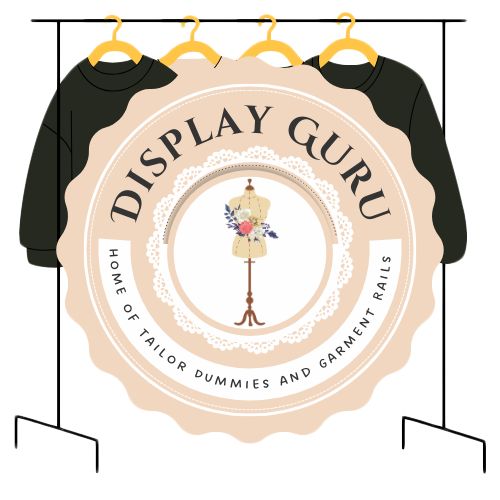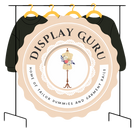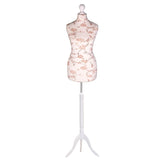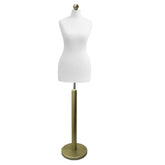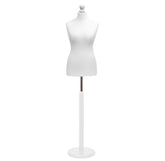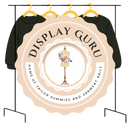Choosing Your Display Cabinet with Glass
A display cabinet with glass isn't just a piece of furniture; it's one of the hardest-working members of your sales team. Think of it as a silent, powerful advocate for your products, working around the clock to frame your best items, boost their perceived value, and pull a customer’s eye right where you want it.
Why a Display Cabinet Is Your Best Salesperson

Picture your most prized products. Now, imagine them on a standard, cluttered shelf. Compare that to the image of them presented elegantly under focused lighting, behind pristine, polished glass. The difference isn't just noticeable; it's dramatic. A quality display cabinet does more than just hold things – it elevates them, creating a dedicated stage where your merchandise is the undeniable star.
This carefully curated setting sends a clear message to your customers: what's inside is special, valuable, and deserves a closer look. It offers a secure, clean, and professional environment that shields delicate items from dust and accidental bumps, all while making them look their absolute best.
The Strategic Value of a Glass Display
Putting these cabinets to work is a cornerstone of smart visual merchandising. Their impact is so well-recognised that the global market for glass display cases, valued at around USD 1.20 billion, is expected to climb to USD 1.85 billion by 2033. This isn't surprising. Consumers are naturally drawn to clear, attractive displays that make products pop while communicating a sense of quality and worth.
In this guide, we'll walk through everything you need to know to make this power player work for your business. We're going to cover all the essentials:
- Selecting Materials: How to pick the right glass and frame to suit your brand aesthetic and security needs.
- Essential Features: Getting to grips with the importance of lighting, locks, and adjustable shelving.
- Artful Arrangement: Mastering the core principles of visual merchandising to build displays that stop people in their tracks.
- Proper Maintenance: Keeping your cabinet looking flawless and protecting your investment for years to come.
By the time we're done, you'll see your display cabinet not just as an expense, but as an indispensable tool for telling your brand’s story and, most importantly, driving sales. For a wider view on presentation strategies, take a look at our guide on retail display solutions.
Choosing the Right Glass and Frame Materials
When you're selecting a display cabinet with glass, the materials you choose are far more than just a finishing touch. They're the very foundation of its appearance, its durability, and how it performs in your space. This isn't just about aesthetics; it's a practical decision that affects everything from customer safety to how clearly your products are seen.
Think of the glass and frame as the stage and scenery for your products. The glass is the window, directly influencing how shoppers perceive what’s inside, while the frame sets the mood, either blending into the background or making a statement all its own.
Understanding Your Glass Options
Let's be clear: not all glass is the same. The right choice depends entirely on your priorities. Are you looking for bomb-proof durability for a busy shop floor, or is crystal-clear visibility for fine jewellery your main goal?
There are three main types you'll come across:
- Tempered Glass: This is the workhorse of retail. It's heat-treated to be up to four times stronger than regular glass, making it incredibly tough. If it does happen to break, it crumbles into small, pebble-like pieces, which dramatically reduces the risk of injury. It’s the standard choice for any public-facing or high-traffic environment for a reason.
- Annealed Glass: This is your standard, untreated glass. While it’s the most budget-friendly option, it shatters into large, dangerously sharp shards. Because of the safety risk, it’s best reserved for quiet, low-traffic areas or perhaps home displays where impacts are unlikely.
- Low-Iron Glass: For absolute, unadulterated clarity, low-iron glass is in a class of its own. By reducing the iron content, manufacturers remove that subtle green tint you see when you look at the edge of standard glass. The result is a completely neutral, true-to-life view of your items.
If you’re displaying anything where colour accuracy is vital—think fabrics, artwork, or cosmetics—low-iron glass is a must. It guarantees that the shade your customer sees is the shade they get, with no colour distortion.
Before we move on, here's a quick breakdown to help you weigh your options.
Comparing Glass Types for Display Cabinets
A breakdown of common glass types to help you choose the best option based on safety, clarity, and cost for your specific display needs.
| Glass Type | Key Feature | Best For | Consideration |
|---|---|---|---|
| Tempered Glass | Safety & Durability | High-traffic retail, public spaces, displaying valuable items | Higher initial cost than annealed glass |
| Annealed Glass | Cost-Effective | Low-traffic areas, home use, budget-conscious projects | Poses a significant safety hazard if broken |
| Low-Iron Glass | Ultimate Clarity & Colour Accuracy | Jewellery, art galleries, museums, high-end boutiques | The most premium and expensive option |
Choosing the right glass ensures your products are not only safe but are also presented in the best possible light.

This visual gives you a sense of how different designs, from freestanding to wall-mounted, can influence factors like the thickness of the glass or the weight capacity of the shelves.
Selecting the Perfect Frame Material
The frame is where your cabinet gets its personality. The material you pick should work in harmony with your products and your shop's overall atmosphere, just as you'd select specific clothing display racks to fit the vibe of a boutique.
Here are the most popular choices:
- Wood: Timeless, warm, and classic. Woods like oak, cherry, or maple bring a sense of tradition and quality, making them a natural fit for antique dealers, jewellers, or high-end craft shops.
- Aluminium: Sleek, modern, and clean. Aluminium is wonderfully light but surprisingly strong, offering a minimalist aesthetic that’s perfect for contemporary galleries, tech stores, or any space aiming for an understated, professional look.
- Frameless: When you want nothing to stand between the customer and your products, a frameless design is the answer. By using minimal hardware to hold the glass panels together, this style puts 100% of the focus right where it belongs: on what's inside. It creates a feeling of openness and is ideal for modern, airy spaces.
Ultimately, your goal is to create a cohesive story. The right materials will ensure your display cabinet isn't just a piece of furniture, but a powerful part of your sales and branding strategy.
Essential Design Features You Cannot Overlook

Once you’ve settled on the basic materials for your cabinet, the real magic happens in the details. The specific design features are what transform a simple glass box into a powerful sales tool. Think of your cabinet as a stage for your products; the right lighting, shelving, and security are the backstage crew ensuring the performance is a hit.
These aren't just minor add-ons—they're absolutely crucial. Getting them right dictates how well your display cabinet with glass actually does its job. Overlook them, and you could end up with a display that’s inflexible, insecure, or just plain uninspiring. Let's dig into the elements you simply can't afford to get wrong.
The Power of Integrated Lighting
If there's one feature that can make or break a display, it's lighting. It’s the single most important factor in making your products pop. Bad lighting can make beautiful items look flat and dull, but the right illumination draws the eye, highlights intricate details, and creates a sense of drama.
This is why LED lighting has become the gold standard. Unlike old-school halogen bulbs, LEDs run cool, which is a massive plus for protecting delicate items like handmade crafts, chocolates, or cosmetics from heat damage. On top of that, they're incredibly energy-efficient, which will save you a good bit on your electricity bill over time.
For your cabinet, you'll generally want to consider:
- LED Strips: These are fantastic for providing consistent, even light along the full length of a shelf, getting rid of any gloomy corners.
- Directional Spotlights: If you want to highlight a "hero" product, these are perfect. They create focused pools of light that give an item a real sense of importance.
The goal is to make your products shine without blinding your customers with harsh glare on the glass. Well-placed internal lighting ensures every item is seen at its absolute best, turning a simple cabinet into a captivating showcase.
Flexibility and Security Features
A display that never changes quickly becomes part of the furniture—and gets ignored. You need the ability to switch things up for new stock or seasonal themes to keep your merchandising feeling fresh and exciting.
That's why adjustable shelving is non-negotiable. It gives you the freedom to accommodate products of all shapes and sizes, from tiny jewellery boxes to tall, elegant vases. This one simple feature lets you completely reconfigure your layout in minutes, keeping your display dynamic.
Security is just as vital, especially if you’re selling valuable goods. A sturdy locking mechanism is essential for your own peace of mind. A quality lock not only helps prevent theft but also sends a subtle signal to customers that the items inside are valuable, which can actually enhance their perceived worth. For those with unique products, looking into custom product display stands can provide solutions built specifically around your merchandise and brand.
Choosing the Right Cabinet Style
Finally, the overall shape and style of the cabinet need to fit your space and your purpose. Think about it this way: you wouldn't use the same mannequin for a swimsuit as you would for a winter coat. You can explore this idea further in our guide on display stands for clothing, but the same principle applies here—different cabinet styles have different jobs.
- Freestanding Models: These are the versatile workhorses. They make great centrepieces or can be placed along a wall to create a major focal point.
- Wall-Mounted Units: An absolute lifesaver in smaller shops. They keep your floor space clear while creating a sophisticated, floating display.
- Countertop Cases: Perfect for placing near the till. They're brilliant for encouraging impulse buys of smaller, high-margin items.
By thinking through these essential design features, you can be sure your cabinet isn’t just a storage container, but a strategic and effective tool for your business.
Mastering the Art of Product Arrangement
An empty cabinet is just a box. It’s what you put inside—and how you arrange it—that turns it into a powerful selling tool. Mastering the layout within your display cabinet with glass is where the real magic of visual merchandising happens. You're not just placing items; you're creating a scene that draws people in and tells a story.
Before you even think about your products, start with a clean slate. Seriously. Give the cabinet a thorough clean, wiping down every shelf and using a good quality cleaner to get the glass absolutely streak-free. A pristine cabinet instantly communicates quality and care before a customer has even looked at the products themselves.
Building a Cohesive Narrative
With your cabinet sparkling, it's time to think about the story. Throwing products in randomly won't work. You need a theme to tie everything together and make a strong visual statement. Grouping items by a single, unifying idea is the key.
Here are a few simple but effective themes:
- Colour Blocking: Grouping items by colour creates a bold, almost art-like display that’s impossible to miss.
- Collection or Brand: Got a new collection from a single designer? Put it all together to tell a complete story and show customers the full range.
- Thematic Storytelling: Think like a magazine editor. You could create a "summer beach day" theme, pulling together different crafts, jewellery, and decor that fit the vibe.
This simple act of grouping brings order to the display and guides the customer’s eye exactly where you want it to go. For a deeper dive into these techniques, it's well worth exploring professional visual merchandising guidelines to really sharpen your approach.
Applying Core Design Principles
Once you’ve settled on a theme, you can start placing your products using a few tried-and-tested design principles. These aren't complicated rules, just simple tricks that create balance and make your display far more interesting. A great one to start with is the rule of three—the idea that our brains find items grouped in odd numbers more appealing.
Instead of lining up two similar vases, try a group of three in different heights. It immediately looks more dynamic and less staged, creating a composition that feels more natural and engaging.
Another fantastic technique is to create visual triangles. By arranging products at different heights, you can guide the viewer's eye through the display. A classic trick is to place your tallest item in the centre and then flank it with two shorter items, forming a simple pyramid. This adds depth and stops the arrangement from looking flat. Understanding how to arrange your products is just as important as having innovative retail display ideas to begin with.
Finally, don't be afraid of empty space. This is often called negative space, and it's your best friend. A bit of breathing room around your products makes each one stand out and feel more special. Cramming every square inch of a cabinet just makes it look cluttered and cheapens everything inside. A little space gives each product the spotlight it deserves.
Cabinets for Food and High-Value Merchandise

While a standard display cabinet with glass is perfect for most products, some items need a little extra care. If you're selling perishable foods or high-value goods like jewellery, your cabinet's job description gets a lot bigger. It's no longer just about looking good; it's about active protection and preservation. These specialised units are built from the ground up to handle very specific jobs.
For anyone in the food business, hygiene and temperature control are everything. A heated or refrigerated display isn't just a piece of furniture—it's a critical food safety device. These cabinets are engineered to hold a precise temperature, keeping pastries perfectly fresh, sandwiches safe to eat, or hot snacks at their most tempting. Humidity control is just as vital, stopping your products from drying out or going soggy.
In the UK, these advanced cabinets have become indispensable for cafes and delis wanting to display fresh food safely. This is part of a huge global market for food display units, valued at USD 25.69 billion and climbing, all thanks to better technology in temperature and lighting. You can dive deeper into the growth of the display glass market on cognitivemarketresearch.com.
Securing and Highlighting Luxury Items
When it comes to displaying luxury goods—think watches, fine jewellery, or rare collectibles—the priorities shift from temperature to security and sheer visual impact. Here, the cabinet acts more like a vault, designed to protect while it presents. This calls for a completely different set of features.
For these premium displays, you'll need to look for:
- Enhanced Security: We're talking about robust locking mechanisms and tough, tempered safety glass. Some even use laminated glass to offer serious resistance against impact and deter theft.
- Specialised Lighting: High Colour Rendering Index (CRI) lighting is a must. It brings out the true fire in gemstones and the authentic gleam of precious metals, with zero colour distortion.
- Anti-Reflective Glass: This is a game-changer. It minimises glare and reflections, creating an almost invisible barrier that gives customers a crystal-clear, uninterrupted view of your products.
For luxury goods, the cabinet's construction communicates value. A secure, well-lit display subtly reinforces the premium quality of the items inside, boosting customer confidence and perceived worth.
Choosing the right cabinet is a core part of your merchandising strategy, directly influencing how customers perceive your most valuable stock. This decision goes hand-in-hand with smart stock control, so be sure to review our best practices for inventory management to tie it all together. Ultimately, the right specialised cabinet ensures your unique items are not only beautifully showcased but also meticulously protected.
How to Keep Your Display Looking Flawless
https://www.youtube.com/embed/eVN3oVys3cs
Your display cabinet with glass is always in the spotlight. Because of this, even a single fingerprint or a fine layer of dust can instantly cheapen the look of your most prized items. Keeping it immaculate isn't just about cleaning; it's a vital part of presenting your products professionally and protecting your investment.
Think of your cabinet as a stage. The performance inside might be spectacular, but a dirty set will always distract the audience. A simple, regular cleaning routine ensures your products remain the star of the show.
Achieving a Streak-Free Finish
The secret to perfectly clear glass is all in the tools and the technique. It's best to steer clear of harsh chemicals like ammonia, which can eat away at frame finishes over time. Honestly, a simple solution of distilled water with a couple of drops of washing-up liquid is usually all you need for a brilliant shine.
For the best, most consistent results, follow this tried-and-tested process:
- Dust First: Before you introduce any moisture, always give the glass and frame a once-over with a dry, soft microfibre cloth. This lifts all the loose dust so you're not just smearing grime around.
- Spray the Cloth, Not the Glass: Lightly mist your cleaning solution onto a separate, clean microfibre cloth. Spraying directly onto the cabinet can cause liquid to seep into frame joints and hinges, leading to damage down the line.
- Wipe and Buff: Use your damp cloth to clean the glass, then immediately follow up with a third, completely dry microfibre cloth to buff it to a perfect, streak-free finish.
Caring for the Complete Cabinet
Of course, it’s not just about the glass. The frame, shelves, and lighting all need a bit of attention to keep the whole unit looking sharp. Different materials need different care, so it’s important to know what you’re working with.
A consistent maintenance schedule is your best defence against wear and tear. A quick weekly check can prevent minor issues from becoming bigger problems, ensuring your cabinet remains safe, functional, and visually appealing at all times.
Get into the habit of checking your lighting for any flickering bulbs and giving the locks a quick test to make sure they're working smoothly. If you have a wooden frame, a good quality polish will keep it looking rich and protect the finish. For metal frames, a simple wipe-down is generally enough. These small, consistent steps make all the difference in keeping your entire display looking its best.
Frequently Asked Questions
When you're looking into buying a display cabinet with glass, a few questions always seem to pop up. Let’s walk through some of the most common ones I hear, so you can feel confident you’re making the right choice for your space.
What Is the Best Way to Light a Glass Display Cabinet?
Without a doubt, LED lighting is the way to go. The main reason is safety – LEDs produce next to no heat and don't emit any of that damaging UV radiation. This makes them perfect for protecting delicate items, whether that’s handmade crafts, antique textiles, or even artisan chocolates.
For the most professional finish, you'll want to find LED strips or spotlights with a high Colour Rendering Index (CRI) of 90+. A high CRI means your products' colours will look rich, accurate, and exactly as you intended. Take a moment to position the lights properly, too; you want to highlight the best features of your products and avoid any harsh glare on the glass.
Should I Choose a Framed or Frameless Cabinet?
This really comes down to the look and feel you're trying to create. A frameless cabinet gives you that sleek, all-glass, contemporary vibe. It puts 100% of the focus squarely on what’s inside, which is ideal for a minimalist or modern aesthetic.
On the other hand, a framed cabinet becomes part of your shop's overall design. A beautiful wooden frame can bring a sense of warmth and tradition, while a metal frame might lend a more industrial or sharp, professional edge. Framed cabinets also tend to offer a bit more structural muscle, which is something to consider for larger or heavier displays.
The right cabinet style isn't just a container; it's a statement piece that reinforces your brand identity. Choose the one that best tells your story.
How Secure Are Glass Display Cabinets?
They can be incredibly secure, as long as you choose the right features from the start. If you’re displaying anything of high value, you absolutely must specify tempered or laminated safety glass. It’s leagues ahead of standard glass in terms of impact resistance.
Beyond the glass itself, make sure the cabinet is fitted with good quality, sturdy locks to prevent any grab-and-run theft. For freestanding units holding particularly valuable items, I'd also recommend looking for models that can be bolted directly to the floor or a wall. That extra step ensures the entire cabinet can’t simply be carried away.
At Display Guru, we provide the essential tools to help your products stand out. Explore our range of high-quality display solutions by visiting https://www.displayguru.co.uk.
